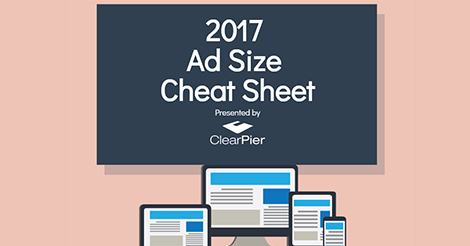How to Write Headlines that Actually Attract Attention
Headlines really matter if you want to attract those clicks and shares.
Copywriters know, whether it’s print or digital, that headlines are essential to your content’s success. The more people who read your catchy headline and have their interest piqued, the more likely they are to continue reading your content and even share it. In fact, David Ogilvy believed that headlines are worth 90% of advertising dollars.
So yeah, good headlines matter, a lot.
But writing awesome headlines that actually attract attention is a challenge even at the best of times for marketers and publishers. With that in mind, we’ve created an infographic that’s going to make your life easier – or at least, your headline writing life easier. Scroll down to learn the best practices now.

Want to learn more? Connect with our team at sales@clearpier.com
Lead Generation: 5 Simple Steps to a Smarter Strategy
These are the best practices for a fail-safe lead generation strategy.
So, you want to learn how to build a lead capturing machine and grow your business. Where do you start? How do you get your landing pages to perform?

What are the best practices for a fail-safe lead generation strategy? Keep reading and learn how to give your marketing strategy a boost now.
1. Define Your Goals and Target Audience
What’s the first step in creating a smart inbound marketing methodology that captures not just leads, but marketing qualified leads? Defining your goals and identifying your target audience!
This is where most savvy Digital Marketers will begin any given campaign. If you haven’t already, start by producing some strong Buyers Personas that depict your ideal customer, in detail. Give them a story. Fill in their needs and their challenges – but don’t just hypothesize. Do some research by interviewing your current client base and speaking to your sales team who are on the front lines with clients. By filling out your Buyers Personas, you’ll be able to see the many different target audiences your business may have.
If you’ve already got your Buyer Personas pinned down, move to the next step: defining your campaign goals. Every campaign, needs a specific, relevant, and measurable goals. Depending on your business needs and your target audience, you campaign goals will vary campaign to campaign.
Not the ‘target’ I had in mind. But if you have your target audience and goals set, then hats off to you.
For example, your target audience may be an existing customer list – visitors who have previously bought from you but have been inactive for sometime. In this instance, your goal is to re-engage this audience and get them to buy again. You may therefore promote a new and exciting offer.
In other instances, your goal is to drive more traffic to your site and bring on prospective clients. In this case, you’ll combine a brand awareness campaign, along side compelling content that adds value to your prospective clients’ lives, and support all of this with retargeting.
2. Engage Audiences with Captivating Content (Videos, Webinars, Guides)
You know what I hate now a days? When I get to the front of the check out line at the mall and before the cashier even starts to ring up my purchase, she asks for my email.
Not in a delightful, ‘Hey, can I have your email because I’ve got a great incentive for you that will be instantly sent to your email now which you will benefit greatly from,’ kind of way. But rather, just a ‘hand over your personal contact information now @#*~%!’ sort of way. Sometimes I feel like I’m being held up at the check out.
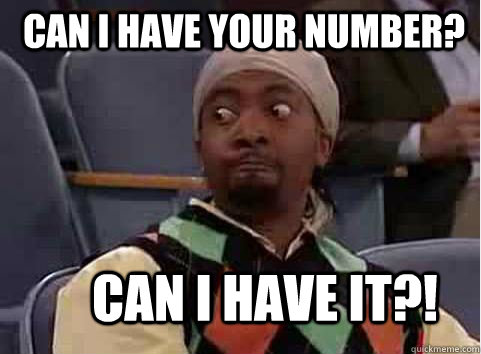
Not in a delightful, ‘Hey, can I have your email because I’ve got a great incentive for you that will be sent to your email now which you will benefit from greatly instantly’ kind of way. But rather, just a ‘hand over your personal contact information now, @#*~%!’ sort of way. Sometimes I feel like I’m being held up at the check out.
Why should I give up my deeply personal contact information if I don’t know a) what your offer is and b) what’s in it for me?
Digital Marketers should be asking the same thing when building out their lead generation strategy. What’s in it for your customers?
Beyond the offer that you’re providing to customers, getting visitors to fork over their personal information and become your lead requires that you provide them with something that will add value to their lives. These incentives can come in the form of educational content like eBooks and guides, digital courses and webinars, or resources like templates, checklists, and presentations, or even in the form of free gift giveaways.
Create compelling content that is worth your audience’s wild, and they’ll be give you their numbah (and email) from left and right.
3. Abide By Form Rules
What should your landing page forms look like? How many fields are too many, too few? Is there even an ideal number?
Just remember this: the number of fields your form uses depends on your offer. The further down the sales funnel your offer, the more details and therefore fields you may require from your leads.
For something as simple as a presentation or use of a free tool, you may only ask for emails. For product demos and webinars, however, you would definitely ask for more information:
- Full Name
- Phone Number
- Title
- Company
The only way to really know, however, is to test, test, test!
4. Use Personalized Testimonials to Build Trust
Adding testimonials to any landing page is going to add credibility to your offer. Word of mouth is perhaps one of the strongest way to persuade someone who is on the fence to buy.
In fact, customer testimonials and reviews have the highest effectiveness rating (89%) for influencing buyers.
Testimonials go further, however, when you add a face to the words and are personalized. Including photos with your testimonials or case studies verifies the human aspect of the testimonial, and asserts it’s honesty.
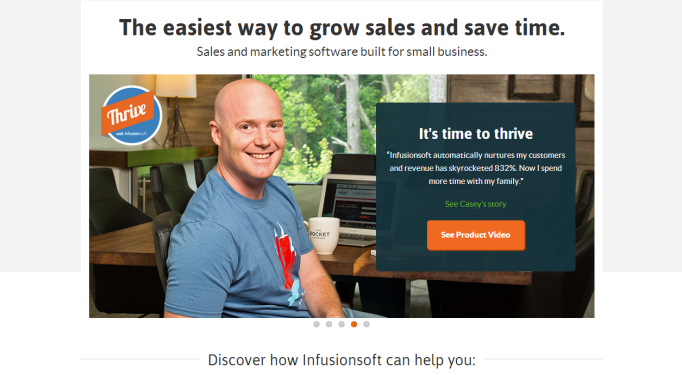
According to MarketingLand, surveys reveal that 71% of marketers see their ROI increase with video ads. That said, it’s worth testing the use of video testimonials to drive leads.

5. Consistently Use an Actionable CTA
Using a strong, actionable CTA consistently for your campaign may be the difference between that final click after the visitor fills out that lead form or just clicking away.
CTA writing best practice is to be specific and describe precisely what will happen once visitors click on the button. Match your message and your action.
Here is an example of a great actionable CTA from Netflix:
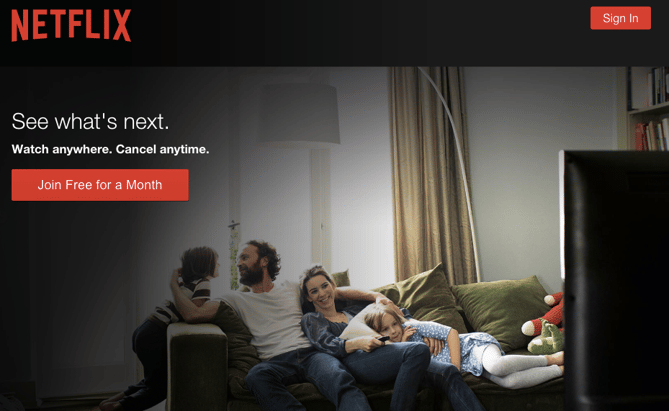
Why is this great?
- Copy is concise
- CTA is specific
- You know exactly what you get when you click
- Clean simple design focuses visitor’s eyes on CTA
- Copy colour and button background colour stand out
Here is a poor CTA example:
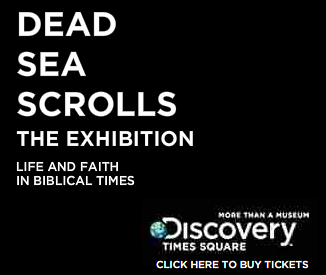
Why does this suck?
- Unclear title makes it unclear what this offer is for
- Where is the CTA button? OH it’s located on the bottom right in font that blends in – viewers can’t even find it!
- If your visitors can’t find your button, they’ll quickly get frustrated and click away – don’t frustrate your viewers!
Keep your CTA relevant, specific, and clear and just watch your leads grow.
And REMEMBER, regardless of the best practice advice you’re receiving out there, there is no better way to get the definitive answer on the right lead generation strategy for your business leads if you don’t test. Test, test, and test! Now go and generate some leads.
http://gph.is/1hAWPrm
Want to learn more? Connect with our team at sales@clearpier.com
How to Most Effectively Retarget Your Customers
Customers subjected to retargeted ads are 70% more likely to convert.
Did you know that customers subjected to retargeting are 70% more likely to complete a conversion compared to non-retargeted visitors.
CTRs for retargeted ads are also significantly higher than regular display (sometimes 10x higher). Those are some impressive stats.
So the question goes: are you retargeting your visitors properly? And I don’t mean, have you got it turned on. I’m saying are you segmenting correctly? Is your frequency cap game on point?
Yes, no, maybe? Say no more! Read on for some great tips on how to most effectively retarget your customers now.
1. Segment everything – literally, everything
Audience segmentation or grouping your visitors based on behaviour is incredibly important for targeting purposes. User behaviour on each of the pages on your site are indicative of the different levels your visitor is at in the buyer journey, and of how of how ready they are to convert.
With this information in tow, you can then create more optimal ad experiences by highlighting the products or services these specific groups previously viewed and directing them back to pages they visited.
For example: Let’s say a visitor viewed both your pricing page and your case studies page, but then wandered off without taking any next steps. While it’s safe to assume they had some interest, you may want to segment them and serve up an ad for your consultation page to catch their interest and re-engage them.
2. Leverage Frequency Caps
When you clicked away, but you're being retargeted with the same ad 50 times a day...
Don’t you hate it when you’ve recently been on a site and then afterwards, no matter where you go on the interwebs, that website follows you around in the form of retargeted ads a million times a day?
Everywhere you turn, at least ten times in an hour, there’s that same exact ad heckling you to buy that one thing you looked at days ago.
Even if a buyer had been interested in the original offer, overexposure can turn a potential convert completely off.
Leverage frequency caps to limit the number of times an ad will be shown to a single visitor so potential buyers don’t tire of your reminder.
Retargeter recommends showing 17-20 ads per month, while ClearPier’s Ad Ops team suggests capping frequency at 3-6 ads/day, particularly if it’s a branded campaign. Terry Kalambalikis, Demand Optimization Manager at ClearPier, reminds us however that this really depends on the type of offer and the needs of the client as well. Different from display, video frequency cap may be set at 1 ad/day, but the smaller cap is also simply the result of fewer avails. Any higher of a frequency cap would affect your pacing.
3. Feel the Burn… Burn Pixel
What might be worst that retargeting without frequency capping? Retargeting the same ad, with an irrelevant message, to a user that has already made a purchase. Your customers are furrowing their eyebrows and asking, “Why are you still trying to sell me this, I’ve already purchased it!”
Your customers RN 'cause, bad retargeting...
Don’t annoy your client base. You want to keep them coming.
To avoid this, use a burn pixel.
Burn pixels is a short line of code that runs on the post-conversion page, usually the ‘thank you page’, will remove users that have already completed a transaction. You can push these users into a different bucket of converted buyers now and serve new ads with more relevant messaging.
The burn code saves you money by helping you reallocate spend. With your audience properly tagged now as an existing customer, rather than a prospective buyer, you can retarget with a new set of ads to upsell, cross-sell or offer new promotions. Previous customers are much more likely to be repeat buyers if you run your retargeting campaigns properly.
So make them feel the burn…pixel!
4. Play with Durations
The duration of your campaign dictates precisely how long your visitor will be retargeted based on their original cookie data. Their retargeting duration can be anything from a day, a week, to a month or longer.
Frequency caps function to limit the number of impressions your visitor will be served throughout your campaign duration. This duration dictates the lifespan of your visitor’s cookie data and at the end of your campaign duration, that cookie is destroyed.
In other words, at the end of your campaign duration, visitors will no longer see your retargeted ads.
Typically longer campaigns run between 30 and 90 days. But beware: even if you have a frequency cap and have set your campaign duration alongside a burn pixel, you NEED to refresh your creatives. Which leads me to my next point…
5. Refresh Your Creatives
Why you ask? People get bored.
YAWN!
This is the biggest risk that can turn off potential buyers that have already indicated that they’re interested in your product or services.
But stale ads are a real problem. What may have appealed to your audience a month ago, may not work a month later.
In fact, Facebook has a subtle way of encouraging advertisers to refresh their ads by slowing down the pacing of an older ad. So, if you want your ads seen and more traffic pushed through, refresh your ads.
6. A/B Test Your Creatives
In addition to refreshing your ads, you should also be A/B testing your creatives to determine which ad is the best performing and eliminate those that don’t.
Testing your creatives will help to uncover which variable of your creative works best. Sometimes all it takes to boost clicks is a button colour change. At others, it’s the image that makes people convert.
If you’re not sure where to start you’re A/B testing, check out our article on A/B Testing 101.
No go forth and start retargeting your audience with confidence!
Want to learn more? Connect with our team at sales@clearpier.com
The Ultimate ABCs of Programmatic Advertising: L to S
In this series, we set out to help you get fluent with the Programmatic language.
*This is part 4 of a series, The Ultimate ABCs of Programmatic Advertising. Last week, we published part 3 of this series. For part 1, click here, and for part 2 click here.
We recently launched this series as an aid for every digital marketer out there who has ever been confused, annoyed, or even a bit frustrated with all the programmatic advertising jargon out there.
In this series, “The ABCs of Programmatic Advertising,” we set out to help you get fluent with all the specific terms and acronyms.
Today, we explore
everything Programmatic
from letters L to S.
Lead
After a visitor completes an action on your page, usually a sign-up/opt-in, or download, or contact form, which suggests their interest in your offer by way of providing your business with their information. A lead is therefore a “potential sales contact.”
Monthly Active User
A metric for the average number of users who are active on a website or in-app per month.
Native Advertising
Originally, native advertising stemmed from the print tradition of advertorials. Native ads in the form of Custom Content refers to digital publications, usually articles, which resemble the look and feel of the publication’s editorial content but is sponsored by the advertiser and intended to promote their product or service. The idea is to provide an organic experience for audiences that is non-invasive.
Native ads also come in the form of In-feed Native ads which can now be served programmatically. In-feed native ads includes promoted listings and paid ads. As In-Feed Native has now evolved programmatically, advertisers are now able to include in a placement elements of an editorial like a headline, images, and video which are automatically customized and arranged to look like an editorial based on contextual content.
Negative Retargeting
Negative Retargeting refers to a process where marketers can prevent an ad from being show to a user to that has already completed a specific action so as to prevent unnecessary overspending. For example, a user that you had been targeting completed the desired action of making a purchase.
Negative retargeting in this case would mean limiting any retargeting ads to users that have made a purchase. For such users, ad dollars would be better spent by running new promotions they have not yet seen or suggesting new products that compliments their recent purchase to ensure all audiences receive only the most relevant ad at any given time in the sales funnel. See also “Retargeting” and “Frequency Capping”.
Omnichannel
Similar to multi-channel marketing, which markets across several different channels, omnichannel is also a cross channel marketing model – with one important difference: customer experience.
While multi-channel considers each marketing channel as separate silos with independent touchpoints that all work together towards a single goal, omnichannel focuses on the customer’s experience of receiving media communication through all potential channels in a unified, seamless, and holistic manner.
The best way to imagine omnichannel is from a birds eye view. “Omni” is Latin for “every/all” and also the root word for ‘omniscient’. Multichannel is more like being on the ground and surveying the landscape across the entire expanse of the horizon.
Omnichannel is all encompassing, includes online and offline, all devices, OOH, digital, and telecommunications as well.
Open Exchange
Sometimes referred to as “Open Auction”, an open exchange is where ad auctions open publicly take place. Unlike Private Exchanges, they do not require closed invitations and anyone can buy inventory.
Page View
The number of a web page is requested from an ad server and displayed to a viewer.
Price Floor
The lowest CPM price a publisher is willing to sell their impressions for programmatically.
Private Marketplace (PMP)
A Private Marketplace or PMP is a closed media buying and selling environment that enables publishers to control the demand partners that they work. PMPs function on an invite-only basis, they also allow advertisers to customize deals to fit their needs by pre-setting targeting parameters, floor rates, and content, and more. Buyers are also given the opportunity of first-hand access on premium inventory that isn’t available in public exchanges. ClearPier is a Private Marketplace offering premium inventory.
Private Auction
A private auction is similar to an Open Exchange but as the name suggests, is private and only select buyers are permitted to bid against a pre-agreed minimum floor price. The difference between Private Auction and PMPs is singularity versus plurality – PMPs generally have a network of publishers and private auctions can happen in one-offs.
Programmatic Ad Buying
Programmatic Ad Buying or Media Buying is an umbrella term that refers to the use of data (behavioural, contextual) and software to buy or sell ad inventory in-real-time to serve ads efficiently and instantaneously, rather than through an RFP (Request for Proposal) and manual IOs (Insertion Orders).
Programmatic is really just using technology to serve ads and while this seems to be a given for digital media, the same cannot be said for OOH or TV yet. Times are changing, however, and vendors are attempting to apply programmatic technology to other marketing streams.
Watch this video for a primer on Programmatic and RTB.
Premium Programmatic
Historically – and this is why originally programmatic advertising received a not-so-great reputation among big brand advertisers – programmatic buying/selling was reserved for lower quality, remnant (unsold) inventory.
Programmatic today no longer necessitates remnant inventory, particularly if purchased on a premium programmatic basis. Over time, buyers and sellers have really benefited from the scale and efficiency of buying programmatic and now also offer “higher quality” or “premium” placements, which demand higher sale prices, programmatically as well.
Programmatic Buy, Guaranteed
Inventory bought programmatically rather than through manual RFPs and IOs, that nonetheless have specified flight times and for specific placements, conducted directly with a publisher. Guaranteed programmatic buys do not necessarily follow the normative auction model.
Programmatic Buy, Non-Guaranteed
On the other hand, Programmatic Guaranteed Buys often refers to the sale of remnant inventory, through a third party, usually ad networks and ad exchanges, rather than directly with the publisher.
Reach
The total number of different people that have been exposed to an ad or piece of content, at least once, over a specific period of time. Reach also refers to how far wide an awareness or branding campaign impacts consumers.
Real-Time Bidding
Real-time bidding refers to the buying and selling of ad inventory on a per-impression basis through live-time auctions that take place in the hundredths of milliseconds that it takes before a webpage loads. It’s likened to the stock market and how auctions work on Wall Street. Real-time bidding is facilitated by ad exchanges and SSPs (supply side platforms).
Remnant Inventory
Remnant inventory refers to ad supply from publishers that have not been sold. Remnant inventory is often seen as lower quality ad placements, requiring more and deeper clicks into a publisher’s website. Remnant inventory is generally sold at a discounted rate and historically have been packaged and sold wholesale to ad networks.
Retargeting
Even if you haven’t looked up the definition of “Retargeting” just by being a participant of the interwebs, you’ve somehow experienced and understand that retargeting are the ads that follow you around the web after you’ve visited a site or completed a certain action.
Retargeting advertising is cookie based ads that target viewers based on your previous browser based internet activities and behaviour. Retargeting is an attempt to drive users back into the purchasing tunnel to complete a specific action like a purchase or sign up.
Rich Media
Rich Media ads or content refers to creatives that have an interactive element which is an added advantage over basic text or display ads, encouraging more engagement from viewers. For example, units like full page overlays, peel downs, expandables, or pops are all rich media formats.
Supply Side Platform
Just as on the buy side, the SSP or supply side platform is the equivalent technology on the seller side of programmatic buying that facilitates the sale of publisher ad inventory. The purpose of SSPs is to ensure efficient selling and maximize revenue.
If you didn’t know, now you know.
Stay tuned for more in our next and final post in this series where we take a look at the T’s to Z’s of Programmatic.
Want to learn more? Connect with our team at sales@clearpier.com
[Infographic] The Complete Social Media, Display and Video Ad Size Cheat Sheet
Bookmark this infographic to help streamline your ad creation process across display, social, and video.
Most marketers will agree with me that one of the most important things you can do for you and your team is to maximize efficiency. For those of us in digital marketing, you know that there is an abundance of various types of ads, ad sizes, dimensions, and formats that creatives come in. The challenge comes when the recommended design specs for ad images changes.
So how on earth can you streamline your work, if the specs keep changing?
In an effort to help make your life (and my life) easier, we’ve created this ad size and dimensions cheat sheet that highlights the main display banner ad formats, video ad formats, Facebook ad formats, as well as those for YouTube, LinkedIn and Twitter. Keep referring back to this cheat sheet as we will update it consistently whenever a new ad size update is announced.

Want to learn more? Connect with our team at sales@clearpier.com
The Ultimate ABCs of Programmatic Advertising: D to K
In this series, we set out to help you get fluent with the Programmatic language.
*This is part 3 of a series, The Ultimate ABCs of Programmatic Advertising. For part 1, click here. For Part 2, click here.
We recently launched this series as an aid for every digital marketer out there who has ever been confused, annoyed, or even a bit frustrated with all the programmatic advertising jargon out there.
In this series, “The ABCs of Programmatic Advertising,” we set out to help you get fluent with all the specific terms and acronyms.
Today, we breakdown everything from D to K.
Daily Active Users (DAU)
The average number of users who are active on a website or mobile app over 24 hours. DAU is a measurement of the “stickiness” of a site or app by showcasing precisely how many unique and active users visit on a daily basis. The main requirement for a user to be considered “active” is that they open to view or engage with a website (or web product) or app in any way.
Data, First Party
First Party Data is widely defined as data owned by the party that initially collected the data. For businesses, this includes information you directly collect about your customers through your CRM, and through surveys and feedback.
In the digital landscape, advertisers and publishers can also collect first party data about the behaviour and actions of audiences that visit their site. This information can be used by publishers to better sell their inventory to advertisers who want to leverage more precise targeting data. First party data is seen as the most accurate and reliable.
Data, Second Party
Second party data is data that is collected by an entity but is then sold from the source, usually through a DMP, to advertisers to improve their audience targeting.
Data, Third Party
Third party data is aggregated collected and owned cookie data from other sources. Third party data is usually provided by a vendor and sold to advertisers who need to reach a broad audience. There is an abundance of third party data, but it is not always seen as accurate.
Data Management Platform (DMP)
A DMP is a technology platform that warehouses and helps manage data. Advertisers often work with DMPs to manage cookie IDs and create specific audience segments for improved ad targeting. DMPs play an important role in the programmatic landscape by facilitating data driven advertising by way of layering audience data over media buys.
Deal ID
In the context of private marketplaces, a Deal ID is the unique number assigned to a buyer and used to identify and match their automated buys with sellers and their inventory, based on a number of trading variables negotiated beforehand. Variables negotiated can include a minimum price for bids, types of ad units available and specific placement location on the site. Deal IDs allow for rules to be set up across buyers working with a seller who then has control over preferential deals for advertisers willing to pay premium prices. Deal IDs also have the added function of helping to keep publishers from having to disclose their inventory in the public marketplace which would effect their direct sales.
Demand Side Platform (DSP)
The technology that helps facilitate programmatic media buys for buyers, most likely marketers, advertisers and agencies. DSPs can be used to manage the purchasing of display, video, mobile, in-app, and search ads by plugging into numerous exchanges. Why use a DSP? The technology makes media buying efficient by allowing a central location for advertisers to buy media across a large volume of publishers, while keeping costs low.
Display
Display advertising is a type of online advertising that comes in several forms, including banner ads, rich media and more. Unlike text-based ads, display advertising relies on elements such as images, audio and video to communicate an advertising message. The IAB provides a standardized guideline for all display ad sizes and formats, now updated for HTML5, found here.
Effective CPA (eCPA)
A measurement of the actual costs spent to generate a specific action – it is used to measure the, well, effectiveness of a campaign. If the advertiser is purchasing inventory with a CPA target, instead of paying per action at a fixed rate, the goal of the effective CPA (eCPA) should always be below the maximum CPA. This fundamental view of what the performance of conversion-based campaign should be is served as the baseline for many buy-side platform optimization algorithms.
Event
A term often used in the customer journey or in-apps, ‘events’ signify the moment a user takes a specific type of action. For example, in-app purchases or app downloads are often labeled an ‘event’.
First-Look
Also known as First-Look Impressions or First-Look Inventory occurs when publishers, marketplaces, and SSPs allow specific advertisers to buy impressions at a set price. The selling process happens in sequences where the impression is shown to the preferred first-look buyer before being shown at any price to other buyers until the first-look buyer declines to purchase the impression.
Frequency
The number of times (how often or frequency) a single visitor is shown an ad over a specified time period, usually 24 hours. Frequency capping is the maximum number the ad can be shown to a single visitor within the time period. For example, a visitor can only be shown an ad a maximum of 4 ads over a 24 hour period. Frequency capping uses cookies to remember the frequency count. Frequency capping is important to avoid ‘banner burnout’ or ‘creative fatigue’.
Geotargeting
The practice of delivering ads or content to a user based on their physical location which is identified by postal (zip) code, IP address, ISP, or GPS data. Geotargeting is important for delivering relevant ads, and is an important innovation for mobile and local advertisers.
HTML5 Ads
HTML5 ads as defined by the IAB “are like mini web pages and require multiple file types to create the ad display and ad features. These files need to be packaged in a way that optimizes load performance and reduces the time it takes to display the ad. However, ad developers may not know how they can produce a visually appealing and interactive ad while making the ad easier to load. In addition HTML5 opens up a diverse set of choices for advertisers and creative designers.”
Impressions
The number of time an ad is shown or served to viewers. It is not a count of the number of unique viewers of the ad impression. A single visitor can be served and see an ad multiple times.
Insertion Order (IO)
This is a term that originates from the early days of advertising when paper was still being used, particularly among agencies. After an RFP (Request for Proposal) is sent out, a proposal by vendors is sent back to the agency. Insertion orders are the final step in the ad buying process that comes from the advertiser or agency that represents their commitment to run a campaign with an outline of spend and flight time. In the programmatic context, insertion orders are sent through ad exchanges.
Key Performance Indicator (KPI)
Key Performance Indicators are metrics that clearly quantify how well or how poorly a campaign meets objectives. In programmatic advertising, KPIs can range from conversions, to CTA, CTR, viewability, to completion rate (for video), and more.
If you didn’t know, now you know.
Stay tuned for more in upcoming posts in this series. Next up, we explore and define the everything programmatic from L to S.
Want to learn more? Connect with our team at sales@clearpier.com
The Experts Weigh in On Programmatic and Performance in the Year Ahead
It comes as no surprise, that more brands are turning to Performance Marketing, and to vendors who can provide the technology to facilitate Performance.
Performance Marketing is on the up and up, year after year. In a recent article on MarTech Today, columnist Jim Yu discussed Performance as an imperative for CMOs worldwide.
At the heart of his discussion, he urges that performance-led platforms should be at the core of the marketing stack. As Yu puts it, “The CMO’s performance imperative demands that they can clearly demonstrate how every element of their spend is bringing about meaningful returns, lest they fall prey to the very real risk of budget-slashing.”
Performance is the overarching concern for marketers everywhere, to justify maintenance and growth of their budgets.
So it comes as no surprise, that more brands are turning to Performance Marketing, and to vendors who can provide the technology to facilitate Performance but not sacrifice scale. But where will Performance lead marketers?
We sat down with ClearPier’s Ad Ops and Client Services team to get a better understanding of the future of Performance Marketing in the year to come. Here’s what ClearPier’s Demand Optimization Manager, Terry Kalambalikis, and Digital Analyst, Albert Ng, had to say about performance marketing.


1. What can we expect for Performance Marketing in the year ahead?
Albert Ng, Digital Analyst:
I believe Programmatic buying will be the base of all digital performance marketing in the future. It’s the only way to move forward with accountable marketing.
The automation of programmatic buying will evolve and be extended towards optimization and contextual/behavioural learnings, in which as a result provide insight and recommendations to accelerate the process of taking the appropriate actions for a better performance
CTR will no longer be true measurement for performance. Instead, it would be primarily be measured through attribution.
Brands and Marketers will begin to realize that attributions requires them start applying processes to verify the data they are running on. Along with quality inventory, marketers will make the attributions part of a broader plan in order to create a solid foundation of data to run the most effective marketing campaigns.
2. What marketing trend or buzzword are you totally over?
Albert Ng, Digital Analyst:
“Engagement.” Honestly, this is probably THE most overused word amongst marketers. It is not an actual measurement of performance, it is a fluff word used to generalize any results of performance. It’s also not specific enough and so doesn’t provide enough insight. Scroll depth, for example, is a strong measurement because it indicates how deeply engaged your visitors are with your content.
Engagement alone will include accidental clicks which can skew your results. Engagement over time, on the other hand, is a more specific metric that actually tells you something: your visitor’s propensity to return after their first visit. Engagement, isn’t enough, you need to expand the metric to get real insights.
Terry Kalambalikis, Demand Optimization Manager:
“Millennial” – What is a Millennial? How do you really define an entire generation with varying interests, hobbies and issues? What really makes them different than anyone else aside from the year they were born?
I mean, you get 29 year olds who may like Hockey, Politics, Movies, Videogames etc., but you also get 50 year olds who can and do like the exact same things just as you get 17 year olds who may be interested in the exact same things. They consume the same content as anyone else, and aren’t the only ones using smartphones or social media.
So how does one market to Millennials? I think this word is over used by pretty much everyone and is just a lazy way to define a group that doesn’t really exist.
3. What do you think the biggest challenge advertisers and brands will now face?
Albert Ng, Digital Analyst:
With so much content being created daily digitally, it becomes difficult to be able to authenticate or verify any third party sources that are being run by the advertisers. Brand safety is going to be the top concern, globally which means only vendors who can guarantee it – or at least has brand safety as a top priority – will win.
Terry Kalambalikis, Demand Optimization Manager:
Not necessarily a new challenge, but I would say Ad Fraud.
There’s no fool-proof way to combat fraud, and no third party actually provides a solution that prevents it. You can monitor it, and possibly action on it once you identify the problem, and use various wrappers that may look out for suspicious traffic and monitor for bots, but in the end, it won’t stop the fraud from happening, and would require media buyers and marketers to actively monitor reports and react on the fly, which is not only a massive, time consuming task, but a task that is likely almost impossible.
Those that enable fraud always find new ways to get ahead of marketers and exploit the system, just the same as how those who create malware and viruses are almost always ahead anti-virus programs, so the fight against ad fraud will be something that will continue to be a problem through 2017, and likely grow into a larger problem as more and more spend is pushed into the digital ad space.
Want to learn more? Connect with our team at sales@clearpier.com
The Ultimate ABCs of Programmatic Advertising: The B's and the C's
In this series, we set out to help you get fluent with the Programmatic language.
*This is part 2 of a series, The Ultimate ABCs of Programmatic Advertising. For part 1, click here.
We recently launched this series as an aid for every digital marketer out there who has ever been confused, annoyed, or even a bit frustrated with all the programmatic advertising jargon out there.
In this series, “The ABCs of Programmatic Advertising,” we set out to help you get fluent with all the specific terms and acronyms.
Today, we breakdown all the B’s and the C’s.
Banner
A web banner or banner ad is a type of advertising you’ll find online and can be delivered on desktop or on a mobile device. Banner ads are the billboards of the digital world and one of the earliest online ad formats as standardized by the IAB.
One of the earliest banner ads was this infamous AT&T ad which ran on HotWired.com back in October 1994 (Business Insider).

Bid
Like the lingo used in stock markets, a bid is the price advertisers are willing to pay for an ad impression. In real-time bidding (RTB), the buying and selling of online ad impressions in the real-time it takes a web page to load, an auction occurs for every impression. The advertiser’s bid is facilitated by a DSP (Demand Side Platform) or through an exchange. For the advertiser to win the auction with their bid, their bid must be higher than all others.
As technology has evolved and targeting parameters improved, the winning bid must also be a strong fit or match for the targeted audience visiting the website at any given time.
Bid Request
When a visitor loads a webpage, bid requests occur in the browser. This is when the ad server requests the ad exchanges which the publisher works with for an auction to take place to buy/sell a specific ad impression. The bid request is sent to buyers through the exchange and received on their DSP which in turn submits their bids in the auction for the impression. The winning bid is then served onto the web page to the visitor – all of this happens within a 100 milliseconds.
Brand Safety
One of the key goals for publishers and advertisers on both sides of the ad trading cycle: to ensure their brand integrity, or brand safety. Ad placements alongside objectionable or inappropriate content can be damaging to a brand, and this is a big concern.
As the digital advertising industry developed over the last five years, brand safety has become a priority.
Brand safety can therefore also refer to the practice of brand protection and use of ad verification tools to prevent objectionable content from being placed on a publishers’ site or vice versa. Some adtechs, like ClearPier, offer multi-level security measures that include technology and human verification.
Click-Through-Rate (CTR)
Click-through-rate (CTR) is the number of clicks that your ad receives divided by the number of times your ad is shown: clicks ÷ impressions = CTR. For example, if you had 5 clicks and 1000 impressions, then your CTR would be 0.5%.
Cost Per Action (CPA, A.K.A Pay Per Action or PPA)
CPA stands for ‘cost per action’. It is an online advertising pricing model wherein advertisers only pay when a completed action occurs, rather than for a set volume. Nearly anything can constitute an ‘action’ from impressions, to clicks, to leads (completed forms), views, or a sale. The desired action is dependent on the advertiser and the goal of each campaign. CPA is the basis of the pricing model for all Performance Advertising.
There are numerous variations of CPA that differ based on the final goal or action: CPA PC (cost per action post view), CPA PV (cost per action post view), CPL (cost per lead), CPC (cost per click), CPV (cost per view), CPI (cost per install).
Cookie

Not quite that type of cookie. In the digital world, a cookie is a small piece of data, or tracker that runs on web browser to track and identify a user’s online behavior and browsing habits.
Conversion
When someone, a potential customer, completes a pre-defined action and/or goal of a campaign such as a click, filling out a lead form, or completing a purchase.
Conversion Rate (CR)
A campaign’s conversion rate is the measure of ad clicks that ultimately result in conversions. To calculate conversion rate, you divide the number of conversions by the number clicks and multiply by 100. For example, you’ve made 100 t-shirt sales (conversions) after 1000 clicks: 100/1000 x 100 = 10% CR.
Cost Per Mille (CPM)
Cost Per Mille (CPM or cost-per-thousand) is another online advertising pricing model where buyers pay on the basis of every thousandth impression or view. CPM is not a new pricing model but was used in print advertising originally.
Cross-Device Tracking

Cross-device tracking is the many ways in which publishers, advertisers and ad tech identify and trace audience behaviour across numerous platforms and devices including desktop, tablets, and mobile phones. The goal? To provide a holistic view of the individual audience member’s behaviour online, regardless of the device they’re using, and enable proper, relevant ad retargeting.
Customer Lifetime Value (CLV)
Customer Lifetime Value (CLV), also known as Lifetime Customer Value (LCV), or life-time value (LTV), is the projected net profit a customer will generate during their time as a customer of your business. There are various ways to calculate your CLV, depending on your business model and goals. Check out this great infographic by Kissmetrics which looks at Starbucks as a case study on calculating CLV.
If you didn’t know, now you know.
Stay tuned for more in upcoming posts in this series. Next up, we explore and define the D’s – G’s of Programmatic.
Want to learn more? Connect with our team at sales@clearpier.com
The Ultimate ABCs of Programmatic Advertising: A is for?
ATD, CPL, DSP, CPA, SDK…
Is this even English?
*This is part 1 of a series, The Ultimate ABCs of Programmatic.
ATD, CPL, DSP, CPA, SDK…Is this even English?
No, you didn’t just read a string of nonsense.
These acronyms, which I’m sure you’re always hearing Ad Ops throw about, are actually representative of important elements of Programmatic Advertising.
But let’s admit it, they can be incredibly confusing.
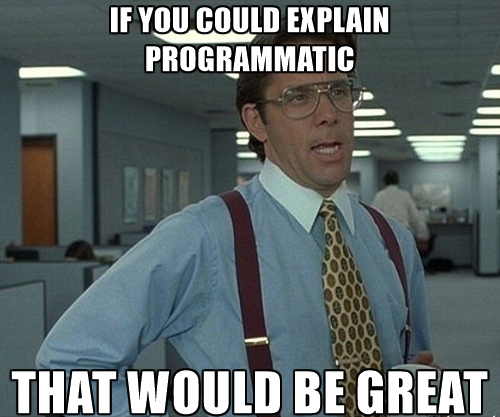
In this series, “The Ultimate ABCs of Programmatic Advertising,” we set out to get you fluent with all the specific programmatic media buying terms and acronyms.
If you’re new to programmatic, this series is for you. Keep reading!
In Programmatic Advertising,
“A” is for…
Ad Server
A technology that offers the means to store and delivers advertisements onto digital platforms including websites, social media, and apps. Ad serving companies also function to count clicks or impressions of ads to help advertisers track their campaigns and return on ad spend (ROAS).
Ad Space
An area of a digital platform, including websites, social media, and apps, that is reserved for displaying online advertisements.
Ad Exchange
Often likened to stock markets, an ad exchange is a virtual marketplace that allows advertisers and publishers to buy and sell ad space usually through real-time auctions. Ad types sold on exchanges can be display, video, and mobile inventory and winning impressions are determined by a set bid price in combination with historical user behaviour, time of day, geographic-location, and device.
Exchanges are beneficial to advertisers because they allow ads to be bought at scale, that is, across a large array of digital platforms at once as opposed to individual, time-consuming direct buys.
Examples: DoubleClick by Google, BrightRoll by Yahoo, Rubicon Project, AppNexus, OpenX etc.
Ad Exchange, Open (Public)
Open ad exchanges, A.K.A public exchanges, are virtual marketplaces that allows advertisers and publishers to buy and sell ad space. Open exchanges are publicly accessible to any advertiser or publisher. Open exchanges have come under fire for a lack of accountability, problems with ad fraud and reliance on third-party data which can limit audience targeting.
Ad Exchange, Closed (Private)
Closed ad exchanges, A.K.A private exchanges, are virtual marketplaces that allow advertisers and publishers to buy and sell ad space. Private exchanges are not publicly accessible to just any advertiser or publisher.
Private exchanges are much more controlled environments where only select advertisers and publishers are invited in to buy and sell. Private exchanges, often run by a large group of publishers, are growing in popularity as they are seen as safer environments with less fraud, as well as first-party data to improve audience targeting.
Ad Network
A company that connects a large number of websites and aggregates ad inventory to sell for a profit. Ad networks originally came about as a way of offering advertisers scale and audience reach. Premium content has historically not been a major concern for ad networks.
Ad networks have been criticized for driving the cost of inventory up as they can and have broker sales between themselves causing the daisy chain problem.
Examples: AdSense, BuySellAds, Conversant etc.
Agency Trading Desk (ATD)
Agency Trading Desks (ATD) are the in-house programmatic ad buying team in advertising agencies. ATDs offers real-time ad and audience buying as a managed service for clients.
Typically the inventory made available through ATDs have been described as remnant publisher inventory – the same inventory sold to ad networks. Complaints about ATDs have arisen around the issue of double paying agencies for both agency services and trading desk services, or conflicts of interest between buyer and seller.
Awareness
The first stage of a full-funnel marketing or purchasing model. Awareness precedes interest, consideration, conversion (and loyalty and advocacy) in the buyer journey and encompasses the moment when potential customers first learn about a product or service.
In the context of programmatic advertising, running awareness campaign is an important prospecting process to help identify potential users or customers. By tracking and measuring ad performance, for example, full video views, early in the buyer process, programmatic media buyers can strategize on how to target these prospects (based on interest) later in the funnel and drive them towards conversion.
If you didn’t know, now you know.
Stay tuned for more in upcoming posts in this series. Next up, we explore and define the Bs and Cs of Programmatic.
Want to learn more? Connect with our team at sales@clearpier.com
5 Creative Tips for Video Ads that Work
Video ad spend continues to grow driven by its ability to engage and strong
click-through rate at 1.84%.
Did you know that by this time next year, US Digital Video ad spend may hit $11.72 Billion? On a dollar basis, US digital video ad spending is expected to reach $28.08 billion by 2020, up from $9.90 billion in 2016 (eMarketer).
Programmatic video buying is also seeing extensive adoption and growth – accounting for 41% of all Digital Video dollars spent. That represents 58% growth over the past 2 years.
The numbers aren’t surprising considering video’s ability to engage and its strong click-through rates at 1.84% (BI Report).
Video is on the up and up as consumers continue to cut ties to traditional media and turn to digital. Audiences are increasingly discovering content, being entertained, and uncovering new brands through video consumption online, most especially on mobile devices.
As demand for video rises, advertisers need to adapt to the new medium to generate maximum results. Earlier this year, Yahoo and Nielsen & Hunter Qualitative partnered to produce a report on native video advertising that also highlighted some best practices for brands to create stronger video ads.
So how can you find success with video advertising? Here are some of the best tips:
1. Use Large Logos
When it comes to video ads on mobile, the larger the logo the better. Large logos can increase brand familiarity by 24%, affinity to convert by 17%, and brand recommendation increase by 33% according to Yahoo.

For Millennial audiences on mobile, affinity conversion increases by 25% when large logos are used – that’s 11.5x higher than on desktop.
So remember to GO BIG with logos.
2. Always Employ a CTA
Consumer purchase intent increases by 14% for video ads on mobile devices if advertisers employ a call to action (CTA).
Encouraging visitors to take a specific action to take them further along your sales funnel. Whether it’s a sign up, call, or click – CTAs represent lower-funnel metrics like purchase intent and brand recommendation which all help measure your ads performance.

3. Optimize Your Creatives for Mobile
When creating your videos keep in mind that on mobile, you can watch video either horizontally or vertically (including vertical landscape and vertical portrait). Optimizing your video ads for screen alignment is therefore extremely important.
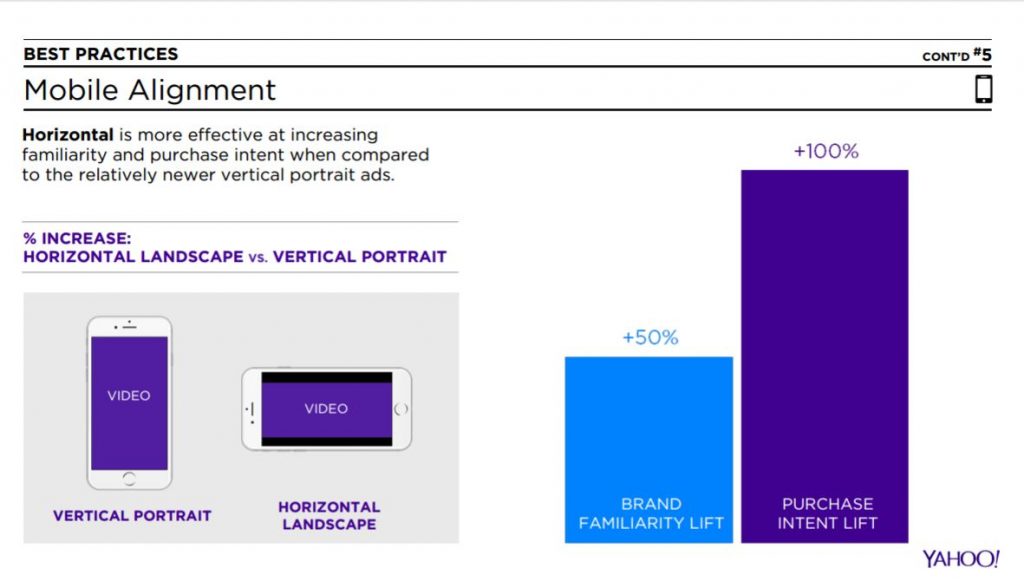 Traditional horizontal landscape videos are the most efficient at driving top and bottom funnel metrics like purchase intent and brand familiarity.
Traditional horizontal landscape videos are the most efficient at driving top and bottom funnel metrics like purchase intent and brand familiarity.
4. Go with Traditional Length for Pre-Roll
We know that the traditional video ad lengths that run for 15-30 seconds work. When videos are shorter, say just 5 seconds, brand affinity conversion, brand recall and purchase intent metrics don’t do so well. 5 seconds may simply not be long enough for audiences to process and recall a brand.
Slightly longer video spots generally perform better, but only if they are entertaining, humorous, interesting, engaging and relevant to the viewer.
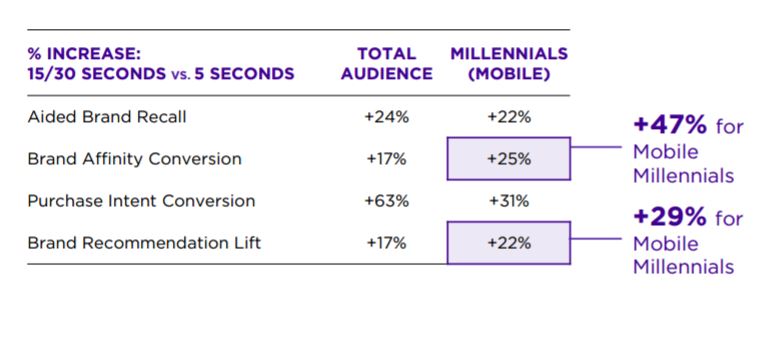
For Native video ads, Yahoo recommends 15 seconds which reportedly drive greater recall and purchase intent.
5. Go Ahead and Auto-Play
Digiday reported earlier this year that 85% of Facebook’s videos are watched without sounds, and other publishers seem to agree.
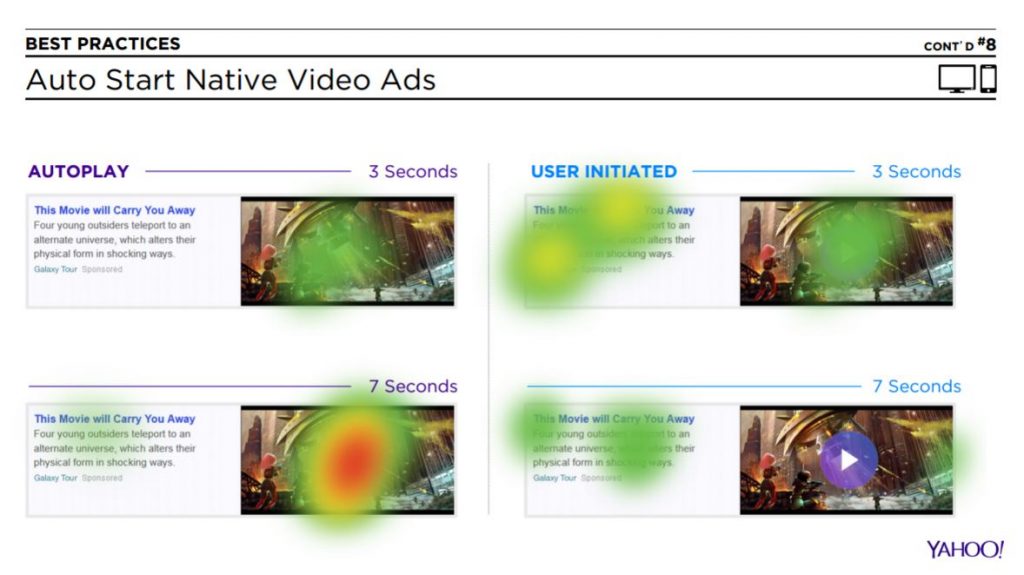
Yahoo advises that auto-pay significantly increases brand recall when compared to user-initiated videos play. Eye tracking indicates that auto-play helps keep viewers focused on the video ad itself, whereas user initiated videos depend more heavily on copy which can negatively impact engagement.
Video ad spend will only grow as the medium matures online and across mobile. But advertisers and brands need to experiment, test and optimize. Just remember to keep these best practices top of mind. Check out the full Yahoo report here.
Learn how ClearPier can improve your video campaigns. Connect with our team at sales@clearpier.com










